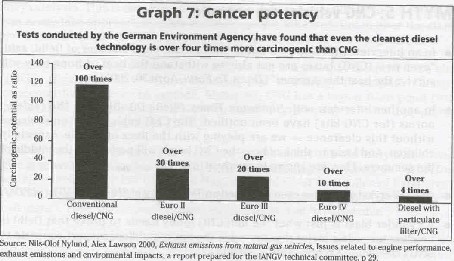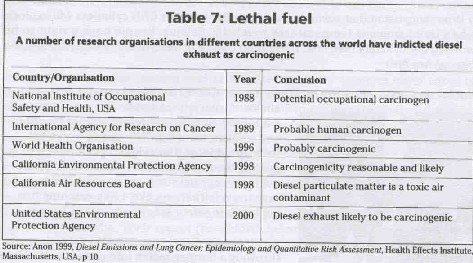Myth
4: CNG causes cancer
Narendra Nath, industry minister of Delhi, said the people he met
at the explosion site told him that, CNG is carcinogenic (The Indian Express,
April 7 2001).
Fact
Conventional diesel is 100 times more, Euro II diesel 30 times
more, Euro III diesel 20 times more and Euro IV diesel 10 times more carcinogenic
than CNG. Emissions from the cleanest diesel vehicles, equipped with particulate
filters and running on best quality diesel fuel are still four times more
carcinogenic than CNG.
3-nitrobenzanthrone, a highly carcinogenic compound found in diesel exhaust
has produced the highest score ever reported in an Ames test, a standard
measure of the cancer-causing potential of toxic chemicals.
Several organisations like the National Institute of Occupational Safety
and Health, USA, International Agency for Research on Cancer, World Health
Organisation, California Environmental Protection Agency, California Air
Resources Board, United States Environmental Protection Agency have indicted
diesel exhaust for its toxicity and carcinogenicity.
A strange rumour campaign raged in the Capital for sometime — CNG
causes cancer. Sensing that this would undermine consumer confidence in
the new technology, CSE organised a rapid survey to confirm if this campaign
was really on. It surveyed about 207 autorickshaw drivers across the city
in Hamdard Nagar, Batra Hospital, Civil Lines, Mall Road, New Delhi Railway
Station, ITO, ISBT, Delhi University, GTB Nagar, and Connaught Place.
CSE was shocked to find out that the rumour was spreading like wildfire.
More than half of those surveyed had heard that CNG causes cancer. Many
thought that the CNG drive would end soon as it caused cancer.
The word spread quite effectively through the network of autorickshaw
drivers. Not surprisingly, all of them had heard about it from “some
friend” or “another auto-driver”. None of them could authenticate
this hearsay with a newspaper report or any organisation. But, quite a
few of the drivers referred to a case filed by Apollo hospital to stop
usage of CNG because it causes cancer. CSE immediately got in touch with
Apollo to find out if this was true. Apollo Hospital confirmed that there
was no such case. Some of the drivers even talked about CNG-related cancer
deaths in some government hospitals recently.
CSE even surveyed a smaller group of taxi drivers, about 30 of them, to
confirm whether they had heard the rumour. Each and every one of those
surveyed had heard the rumour on cancer and CNG.
Diesel
and cancer
In 1998, CARB declared diesel particulates to be toxic air contaminants.
A number of other research organisations and regulatory agencies too have
branded diesel fumes as a likely carcinogen (see table 7: Lethal fuel).
If the cancer-index for fuels — potential of emissions from different
fuels to cause cancer — is taken into consideration then CNG is still
the safer option than diesel. A study conducted by the German Federal.

Environmental
Agency (UBA) shows that Euro IV diesel vehicles using ULSD and fitted
with CRT would be over four times more carcinogenic than CNG vehicles.32
It is to be noted that Euro IV technology is still under development and
will be introduced in Europe in 2005 (see graph 7: Cancer potency).
A compound discovered in the exhaust fumes of diesel engines may
be the most carcinogenic ever analysed, say Japanese researchers. They
warn that it could be partly responsible for the large number of
lung cancer cases in cities. The compound, 3-nitrobenzanthrone, produced
the highest score ever reported in an Ames test, a standard measure of
the cancer-causing potential of toxic chemicals. “I personally believe
that the recent increase in the number of lung cancer patients in vehicle
congested areas closely linked with respirable carcinogens such as 3-nitrobenzanthrone,
“ says Hitomi Suzuki, a chemist at Kyoto University who led the study.
Emissions from truck engines and the air above central Tokyo both contained
the compound. It has been found to be more dangerous than 1,8-dinitropyrene,
which is also found in diesel exhaust and had until now been constituted
the most powerful known mutagen33 (see table 7: Lethal fuel).
